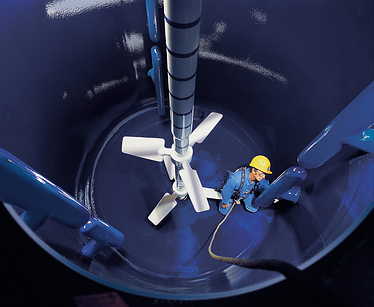Tips for Working Inside Glass-Lined Equipment
 There are certain areas in a chemical manufacturing facility, such as a reactor, storage tank, or other large vessel, that are not designed for people but are sizable enough for employees to enter to carry out maintenance work and other housekeeping tasks. Defined as “confined spaces” by OSHA, these areas usually have limited access due the equipment’s physical arrangement as well as its potentially harmful contents that personnel try to avoid contact with under normal circumstances. Despite the restricted space and potential hazards, it becomes necessary for a worker to enter a vessel from time to time. Care should always be taken during any type of entry primarily for the safety of the worker, but also for the well-being of the equipment. Glass-lined steel vessels present some additional precautionary steps that need to be taken into account to ensure the safety of both the worker and the equipment.
There are certain areas in a chemical manufacturing facility, such as a reactor, storage tank, or other large vessel, that are not designed for people but are sizable enough for employees to enter to carry out maintenance work and other housekeeping tasks. Defined as “confined spaces” by OSHA, these areas usually have limited access due the equipment’s physical arrangement as well as its potentially harmful contents that personnel try to avoid contact with under normal circumstances. Despite the restricted space and potential hazards, it becomes necessary for a worker to enter a vessel from time to time. Care should always be taken during any type of entry primarily for the safety of the worker, but also for the well-being of the equipment. Glass-lined steel vessels present some additional precautionary steps that need to be taken into account to ensure the safety of both the worker and the equipment.
By following the guidelines below, which are further explained in Materials Technology Institute’s Repair and Damage Assessment for Glass-Lined Equipment (written by Sal Falcone and Bert Moniz), you can ensure that you are following the rules outlined by OSHA for confined space vessel entry. While individual plant safety rules and corporate preferences take precedence over the information in this post, this article provides guidance for working inside glass-lined vessels.
Number of Workers
Unless two people are required (which is rare in the case of typical repairs and installations), no more than one person should be in a vessel at a time. A second worker should be stationed in close proximity outside the vessel to offer any assistance and oversee work being performed.
Clothes and Shoes
Prior to entering the vessel, the worker should remove all loose objects. This includes pens, keys, cell phones, and loose change - anything else that can be found in clothing pockets. Also, any exposed metal buckles or edges should be removed when possible or covered with tape. Clean rubber-soled shoes or sneaker should be worn, preferable ones that are reserved solely (no pun intended) for working in glass-lined equipment. Even shoes whose bottoms are manually cleaned might have small debris on them from walking outside that could cause damage to the glass lining. When looking into a vessel opening, remove your hard hat or make sure it is strapped securely to your head. (While some of these tips can seem common sense, you would be surprised at how often simple safety measures are overlooked!)
Tools
Non-metallic, light weight tools constructed with rubber or plastic housing should be used at all times. Even with the proper MOC, tools should be handled carefully to avoid impact with the glass lining that could cause abrasions or fractures. Any solid object that comes in contact with the vessel walls puts the vessel at risk for damage, so every precaution should be taken with tools and other items that need to be brought into the interior. By confining them to a secure container (think canvas or cloth, not a bulky solid tool box) and lowering them into the vessel after the employee has entered, you can safeguard against potential detriment.
Lighting
Most confined spaces that feature small openings require an additional light source to provide better visibility for inspection and evaluating defects in the event that a spark test is being performed. Lights featuring rubber-molded housing provide an added safety measure to protect the glass lining. When repairs are being made and more extensive lighting is required, quartz or fluorescent bulbs should be used.
Ventilation
In the case of vessels that require ventilation upon entry, an air mover should be used. In order to protect the glass lining from damage, it is a best practice to install the ventilation system with an envelope gasket between its metal flange and the glass-lined nozzle flange. This setup also provides a tight seal to most efficiently aerate the vessel.
Mats
A rubber mat should be placed on the vessel floor prior to entry. This ensures the worker won’t slip and will also act as a protective covering to shield the glass. Rubber matting is readily available to purchase in various sizes and thicknesses (a minimum of ¼” is recommended) at most major hardware stores or from industrial supply stores and websites. Cardboard can be an effective substitute, though, when a rubber surface is not available. If the mat is left in the vessel for an extended amount of time, it should be inspected for condensation between the surfaces, which could create a slipping hazard.
Ladders
Similar to the rules related to the material of construction of the tools and other various items that are brought into a vessel, a metal ladder should never be used in a glass-lined vessel. Wood ladders are preferred (with rubber padding on the top and bottom); however rope ladders with wooden slats and all-fiberglass ladders are also sometimes permitted pending your site’s approval.
Manways
When manways are left ajar, the openings should be covered with cardboard in between use to inhibit any foreign objects from accidentally falling into the vessel. When it’s time to close the manway, make sure that the gasket is in place as well as a PTFE nozzle protection liner, which will effectively protect the glass gasket face when the manway is in contact with it. The manway protection ring can be retrofitted and requires gaskets on either side. Additional consideration can be taken to help regulate the rate at which the manway closes. This is done via a manway assist that uses a hydraulic spring. Any clamps of j-bolts that have been partially unthreaded should be secured with a retaining ring to avoid manway damage.
Bringing Accessories into a Glass-Lined Vessel
When you are transporting glass-lined components and parts into a vessel for installation or change out, extra caution should be taken to avoid contact with the glass-lined walls of the vessel. Not only do you want to prevent damage to the vessel, but you want to keep the ancillary parts in tact as well. To help protect the agitator, baffle, or other item that you are installing, make sure you wrap the entire piece in clean cloth or rags and tape them into place so they don’t shift during the transfer. Additional padding is sometimes required depending on the size and fragility of the part.
Practicality and good judgment go a long way when it comes to working inside a confined space. Still, it never hurts to review the basics to confirm you are making the right choices for the safety of all the workers involved along with the well-being of your glass-lined equipment. If you think at any point you are doing something that puts either yourself or the vessel in danger than it’s best to consult your workplace’s policies for clarification on a procedure. The extra time taken to ensure something is done correctly is much preferred over a bad injury or a costly mistake. For more information about glass-lined equipment maintenance consult our maintenance manual or download our new Glass-Lined Equipment Inspection eGuide.


